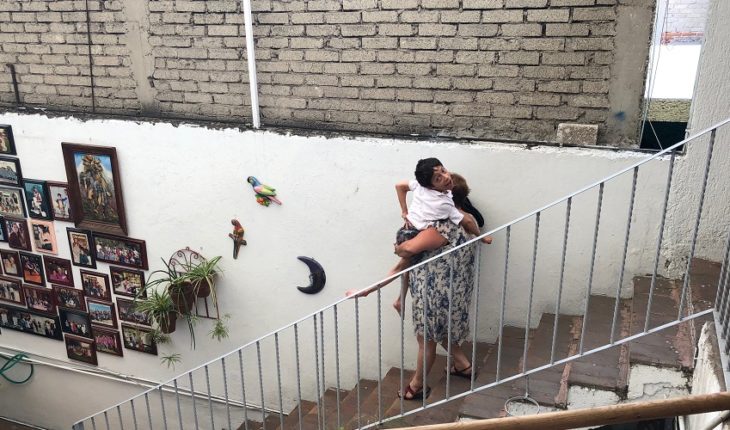each morning, Patricia Osnaya rises to prepare for their classes to Inti, their 12-year-old son. Does breakfast, leaves school and goes to work. Leaving runs back home to prepare food for when the transportation take the child, both eat and then go to your therapy. Inti has 12 years and cerebral palsy, so his mother loads it up and down stairs whenever they come out.
Patricia and her son living at home from their parents, who died of cancer after having it for two years, time in which took care of them. In four years, he cared for the same time of three dependants, without stop working.
In Mexico there are 42 million people requiring some kind of care; 33 million are under the age of 15 and 9 million are adults over the age of 65, according to the figures from the national population Council (Conapo). The Agency projected that by 2030-dependent persons come to 45.3 million, by 2050 will amount to 51.4 million.
52% of Mexican urban households that have at least one member in a condition of dependence. Like Patricia, Elizabeth Vargas has been caretaker of their children and their parents at the same time. Sitting in the room of his home in the State of Mexico, Elizabeth Vargas looks at two of the people he loves most and which are, at the same time, the longer and more arduous of his life project: her daughter and her mother. The first even cares to their 36 years for refractory epilepsy suffering; the second because it already has 80 years and diabetes puts it at constant risk.
Elizabeth is still young but care for two dependents to the 56 years isn’t something simple; However it does so with gusto and gratitude because her mother was precisely who helped raise the small Isaura, when she was forced to have two jobs to support his family.
Mexican homes within this work is done in almost 80% by women. Photo: Claudia Altamirano.Ambos cases are part of the 52% of Mexican urban households that have at least one member in a condition of dependence, according to the labour survey and Social co-responsibility (ELCOS) in 2012 from the National Institute of statistics) INEGI). The reference are the cities because they concentrate one population much larger than rural areas.
What Elizabeth and Patricia is unpaid care work which according to the international organisation of Labour Organization (ILO), consists of two types of activities: those of care direct, personal and relational – how to feed a baby or taking care of a spouse sick – and indirect, such as cooking and cleaning handling activities. All people need care and at different stages of their lives will be its beneficiaries: children, older adults, people with disabilities and eventually, pregnant women or sick.
Worldwide, care is the most sought-after work and their tendency is growing: in 2015 there were 2,100 million people in need of care (1,900 million children under 15 years and 200 million older adults), according to the international organization of the Labour (ILO). By 2030, it is expected that the number of beneficiaries of care on the planet will be 2,300 billion.
The accelerated ageing of the population is causing the index of dependency to grow rapidly, according to the most recent projections of the Conapo, published in last September. In this 2018, the rate of aging as the Council is of 27.3 points, 2030 will grow to 45.8, and continue at the current rate, by 2050 will reach 93.7.
Also independent adults require indirect care to develop. “Such activities may seem irrelevant, but without them the social, economic and political world would not launch;” If they are not determined, no subject would carry out their day-to-day work with full time available, and other areas of social interaction would not work properly”, warns the researcher of the UNAM Pilar Velázquez.
Just this high demand, Inegi said that care work is equivalent to the 23.2% of the gross domestic product (GDP); i.e. If it is remunerara to all those who do, it would be the largest productive sector, trade and manufacturing industry. You add the work unpaid in consumption goods (such as sow and harvest their own food) this figure amounts to 24.9%.
Despite this, the supply of public services to meet these social needs is very low, because there is a system that integrates all the initiatives to cover the entire population: there are only scattered programs in some institutions or for workers of the formal sector, which barely accounts for 40%.
It is for this reason that these needs are met by families, and within households, this work is done by almost 80% by women. Agencies and experts agree: women are doing the work of the State.
attached to the informality
the ILO research, the College of Mexico, human rights commissions national and capital, the Chamber of Deputies and feminist organizations refer to many women who have a family member Manager can only accept a job when it gives them the opportunity to combine it with their duties of care, which limits them to part-time jobs, informal, underpaid or in irregular conditions.
In an ILO study on trade to the wholesale, interviewers asked women with micro businesses in city of Mexico why self-employed. The response of the majority was that they need flexibility to schedule to continue seeing young children and chores at home.
“Care is a great constraint for women access to decent work, because this conditions them to accept precarious working conditions, to work in the informal economy; because this allows them to combine care and domestic work with the paid time”, said in an interview Soledad Aragon, national officer of formalization of the use of the ILO.
And it is the work of care includes a wide variety of activities that require time, and therefore hinders the opportunities for women to access the labour market under more favourable conditions, as well as their participation in social activities, policies, training, and recreational points out the ‘Women and men in Mexico 2017’ report of the National Institute of women (Inmujeres).
“that limits your life and professional development, we are always looking for part-time jobs. “Considered that women’s time is infinitely elastic, that here we are and that we will continue where there is less chance of moving work to the paid sector”, added Lucía Pérez-Fragoso, author of the study ‘who cares in the city?’, the Commission Economic for Latin America and the Caribbean (ECLAC).
In the world, the main reason indicated by age women work to be out of the labour force is the work of care, unpaid, while for men, the main reason is to be “studying, sick or disabled”, adds the report of the ILO. And in those cases, is a woman who takes care of them, as the sister of the Lady Lilia, who currently cares for two grand-daughters that his daughter left him when he went without saying where, and his spouse, whose disease alcoholism for permanently disabling.
absence of State
in Mexico only one of the 32 entities has presented a comprehensive initiative to create a system of care, derived from the recently recognized right to care, provided for in the new Constitution of CDMX. Although it is intended to be a scheme similar to Uruguay – the only country in Latin America with a system of care-, the experts on the subject are not satisfied yet with the proposal, because they consider that it still does not put at the Centre the right to the care.
“The proposal for the CDMX says that there will be a tax incentive for companies that participate. It could not be more blurred the State there”, said Gabriela Ríos Cázares, specialist in geriatrics and Member also care network.
In the rest of the entities, or at the federal level, there are plans or global projects for care. Some institutions offer stays or care to meet these needs, but retain the welfare approach and targeting specific vulnerable groups: people homeless; older but independent adults without psychiatric disorders; children but only if there is no guardian or if their mother works (such as the nurseries of the Mexican Institute of Social Security). The requirements are that only some can access these services and not any worker who required care for dependent relatives.
It is also necessary to check the quality of the services and benefits that already exist, warn researchers, as many are poor but are within the range of the State, although not serve workers.
One of the most common examples are the constraints that public hospitals put the families of sick children: the only ones authorized to make Guard are the parents and must stay there 24 hours. So they must leave their jobs and can not take hold of the family network that tends to support the care.
It was the case with Elizabeth Vargas and her daughter. In one of the many occasions in which the child was hospitalized, lasted a month and a half in a coma, during which Elizabeth had to attend the entire day and absent from his work. “It was an area of intensive care and only allow the mother to be. Or grandmother, no one. Then I had a very strict Director, I told her to please let me leave me because if it was not going to the hospital, they immediately sent the workerto social. I had a writing where almost accuse me of leaving employment, but my Union could intervene and I continued working,”recalls Isaura.
Paty Osnaya also was forced to undertake labor battles to keep his job, also in a school of the Secretariat of public education (SEP), for leave to care for his son. Although she has a feature called ‘Maternal care’ that gives you permission to Miss five days to work when the child sick, her employers decided to suspend their payments because it had already had “many absences”. Patricia won the case, payments were reinstated him and it retained the employment, but the relationship with his superiors was more and more difficult because they had already stigmatized it as someone who almost never arises to work.
In the Chamber of Deputies tabled initiatives relating to this type of work, but they are specific for any of its edges: to provide occupational absences of less than a year to workers who need to take care of someone, without pay but respecting its square; or to balance work with private life, so that caregivers have plenty of time for their work. Neither is to create a complete system that meets social needs of space, material and human resources to perform the tasks of care that require workers to their families.
In addition, Soledad Aragon warned that Mexico has not ratified the ILO conventions that would make more compatible the paid work which is done at home: the 156 on workers with family responsibilities; the 183, extending maternity leave to 14 weeks, against the existing 12 in Mexico; Neither the 189, through which the domestic workers can obtain benefits such as child care for their young children.
In his report, the ILO urges Governments, employers, trade unions and citizens of all countries to take measures in regard to the Organization of the work of care, coping with aging societies, changing families, the place yet side of women in labour markets and deficiencies in social policy.
“If not they are dealing properly, the current deficits in the provision of care and its quality will create a serious and unsustainable crisis of care around the world and will increase more even gender inequality at work,” anticip to the International Labour Organization.
this publication was made possible through the support of Kellogg Foundation.





